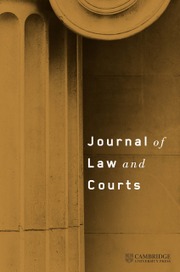No CrossRef data available.
Article contents
Measuring Ideological Polarization on the Circuit Courts of Appeals 1953-2022
Published online by Cambridge University Press: 20 November 2024
Abstract
Attention to ideological polarization in the Circuit Courts of Appeals has surged in recent years. However, no valid cross-circuit cardinal measure of polarization has been established. The lack of a valid cross-circuit measure of polarization has limited scholar’s ability to evaluate broad trends in judicial polarization and address how ideological polarization influences judicial decision-making. To address this, I develop a new measure of ideological polarization for each of the Circuit Courts of Appeals between 1953 and 2022 using the polarization framework established by Esteban and Ray (1994). I then theorize that in order to uphold the norms of collegiality, more polarized courts are likely to take strategic actions to avoid breaking consensus. I show that polarized courts deliberate longer before releasing opinions, are less likely to give cases with a full hearing, and are less likely to publish justified and signed opinions. These results have implications for the efficiency, efficacy, and authority of the Circuit Courts of Appeals.
- Type
- Research Article
- Information
- Copyright
- © The Author(s), 2024. Published by Cambridge University Press on behalf of the Law and Courts Organized Section of the American Political Science Association
Footnotes
The author would like to thank Lucia Lopez, Eugengia Artabe, and Billy Justus for their helpful feedback. A previous draft of this paper was presented at the American Political Institutions Workshop at the University of Houston. I would like to thank all participants for their helpful feedback.
Replication materials for this article are available at the Journal of Law and Courts’ Dataverse archive.


